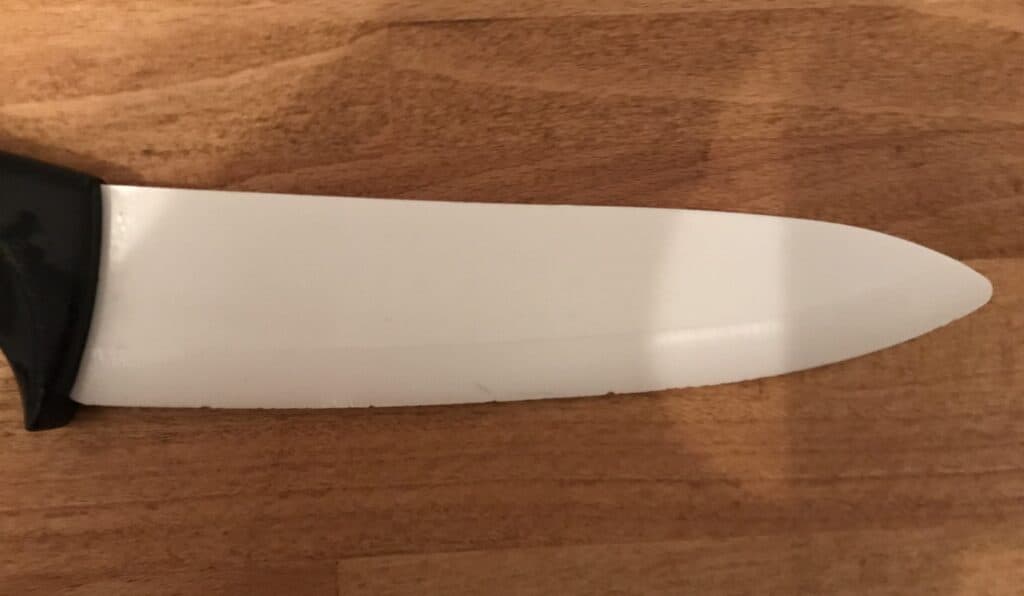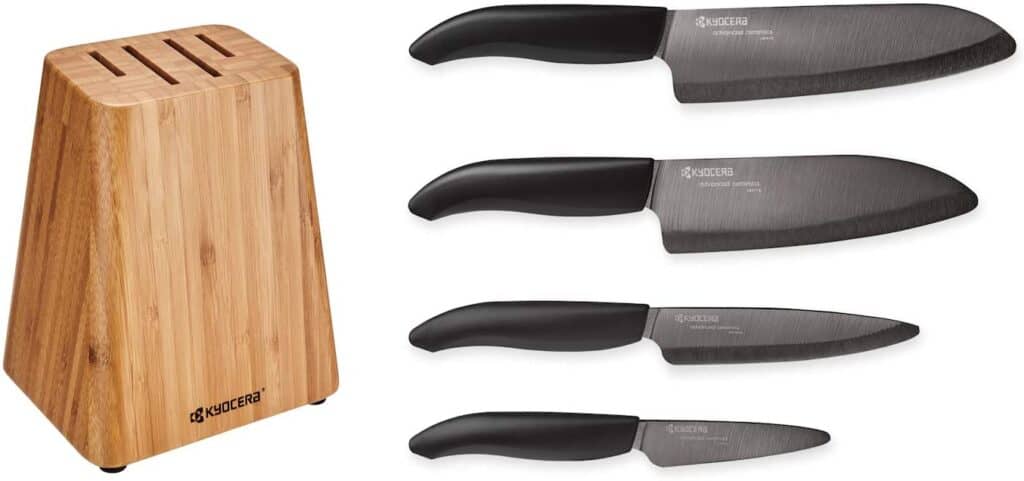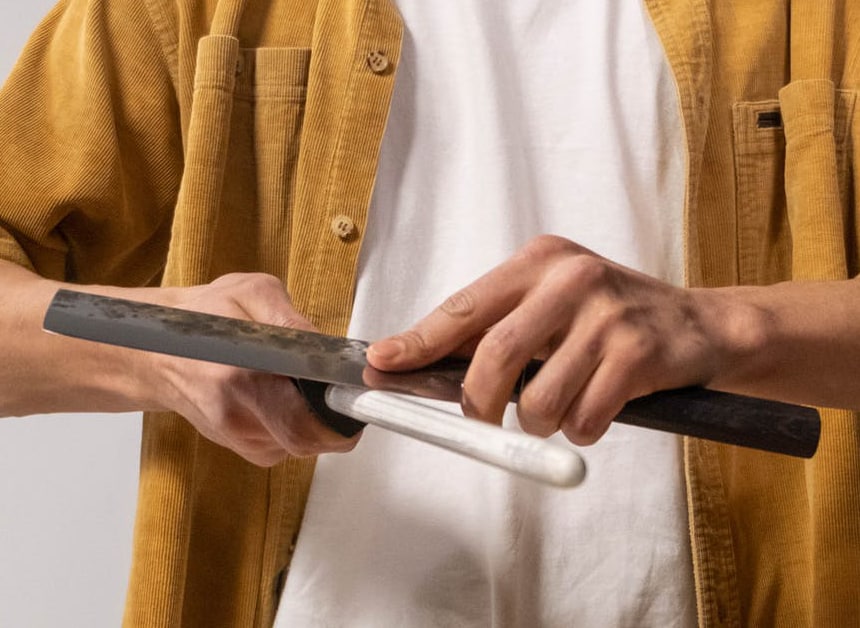
Ceramic knives have a reputation for being sharp. It’s kind of the whole point of ceramic knives really.
And it’s a very good selling point. Personally I’m a big fan of using ceramic knives for certain tasks in the home kitchen, they have many benefits on steel knives if used correctly.
So, how about that main selling point, the sharpness. Are ceramic knives sharper and how long do they really stay sharp.
In this article I’m going to look into that question, why are ceramic knives sharp in the first place and exactly how much longer than steel knives do ceramic knives retain a sharp edge.
I’ll also touch on how you can actually sharpen a ceramic knife once it does go blunt or gets damaged.
Quality ceramic knives can retain their sharpness up to 10 times longer than equal quality steel knives. However, this very much depends on how well you maintain your ceramic knife. They are less verstitle than steel knives and are easy to chip. Ceramic knives should only be used for certain food types and misusing a ceramic knife will vastly decrease how long the edge remains sharp.
Why are ceramic knives sharper than steel knives
The sharpness of a knife generally comes down to the hardness of the material.
This is why ceramic knives are sharper than steel knives. Ceramic is very hard, it’s so hard that it can be used to sharpen steel knives, it’s actually my favorite knife sharpening material.
A harder material means that the edge of the blade can be sharpened to a more acute and finer point and thus the blade edge is sharper.
Now, most steel knives could technically be sharpened to a very acute edge as well, but the thinness of the steel would not have enough strength and would easily bend and twist out of shape very quickly, or it may even chip.
That’s all happening at a microscopic level so you might not be able to visually see the blade deforming because it would lose that edge much more quickly than a ceramic blade.
A simplified comparison could be an eraser, the thing you use to rub out pencil marks. You could sand down an eraser to a very sharp point but that point would have very little strength.
Ceramic, as a harder material than steel, can still retain its shape even when sharpened to a very acute angle, and that’s why ceramic knives are sharper than steel knives.
Do ceramic knives break easily
Ceramic knives can break easily and this is where the question of how long ceramic knives stay sharp becomes tricky.
Ceramic blades will last a very long time if used correctly, and a quality ceramic knife can easily last 10 times longer than a steel knife of equal cost.
However; if you plan on that happening you will need to take very good care of your ceramic knife and only use it for certain types of food.
Ceramic is a very hard material but it is also very brittle. You can draw comparisons to ice. Ice can be extremely hard and form a sharp edge (just ask the Titanic) but if you drop a block of ice it will also crack and shatter.
This is the same for ceramic. It’s very hard but can easily chip or even snap if subjected to short sharp shocks or if it’s twisted.
How to keep a ceramic knife sharp
There are two main things you need to avoid with a ceramic knife if you want to keep it sharp:
- Do not cut food with hard sections, such as meat containing bones or fruit containing stones.
- Do not let a ceramic knife get ‘knocked around’, for example, not using a dishwasher or placing in a loose cutlery drawer.
Using a ceramic knife for the correct food is the thing most people get wrong. A ceramic knife is not an all-rounder knife.
A ceramic knife should only be used for soft foods, things like fruit and vegetables that do not contain hard stones and boneless meat.
They are very good at cutting through these soft foods and since ceramic is also chemically inert (unlike steel) cutting with a ceramic knife actually keeps these foods fresher too.
Ceramic knives should be used for cutting only. You may use the flat side of your blade for things like crushing garlic cloves but this kind of sideways pressure can snap a ceramic knife.
Lastly, regarding maintenance. Always wash a ceramic knife by hand, not in a dishwasher and not in a kitchen sink full of other plates and cutlery.
It’s also best to store your ceramic knife with either a blade sheath or in a knife block to protect the blade for little chips that can occur from movement caused by opening a shutting drawers.
How to sharpen a ceramic knife
If you take extremely good care of your ceramic knives then you may well never need to sharpen them. They do retain their sharpness very well if used on the correct food and stored with care.
But the truth is that eventually most ceramic knives do chip, even if only a little. It’s not easily keeping such good care of a knife, especially if you’re in a family kitchen where anyone might use it!
The good news is that even if the blade does chip, ceramic knives can be sharpened, you just need a material harder than ceramic.
And that material is diamond, yes… diamond!
It’s not as expensive as it sounds. Diamond stones are flat, abrasive tools that use diamond dust as the abrasive material.
They essentially allow you to sand down each side of the blade to unveil a new sharp edge.
I wouldn’t recommend using any pull through sharpeners for ceramic blades, they could end up making things worse, and things like whetstones will take forever to sharpen because ceramic is so hard.
To sharpen using a diamond stone you gently scrape the blade along the edge of the stone, at the angle of the blade edge.
It’s very important to be gentle and not apply too much pressure to the ceramic blade, as we’ve discussed too much sideways pressure on a ceramic blade could snap it.
Just be sure to sharpen each side of the blade an equal amount and you’ll have a freshly sharpened ceramic blade.
If you need a diamond stone then I would recommend the LK-WORLD stone, I’ve also got a review of it at the bottom of this page.
My ceramic knife recommendation

View on Amazon (opens new tab)
I would highly recommend this 5-piece ceramic knife set by Kyocera.
Kyocera have a great name for using some of the best ceramic as the blades for their knives. They are super strong and extremely sharp.
The benefit of buying this set is that you get a range of knife sizes but you also get the very useful bamboo knife block to store them in.
This will eliminate the possibility of the knives becoming chipped or damaged during storage and will not doubt let them last much longer.
It’s actually quite rare to find ceramic knives that come with a knife block (don’t ask me why because it makes total sense!), so the fact that you can get these Kyocera knives, some of the very best on the market, and a block to go with them is perfect.
My diamond stone recommendation

View on Amazon (opens new tab)
If your ceramic knives ever start to go blunt, or if they get those little chips along the blade, then you’ll need a diamond sharpening stone.
This 600 and 1,200 grit stone by LK-WORLD is ideal. The corse 600 grit side does a great job of quickly filing down the blade to eliminate those chips, then the 1,200 grit side can be used to create a smooth and super sharp finish to the blade.

